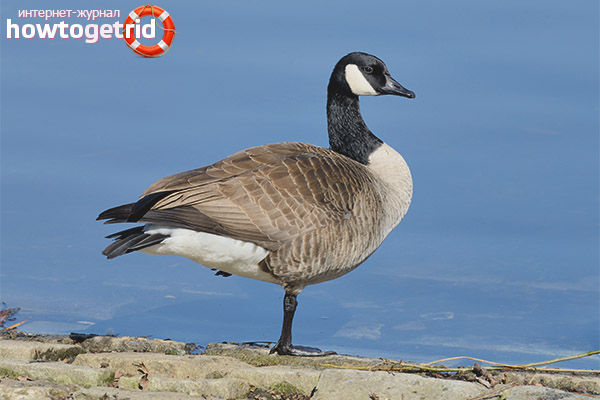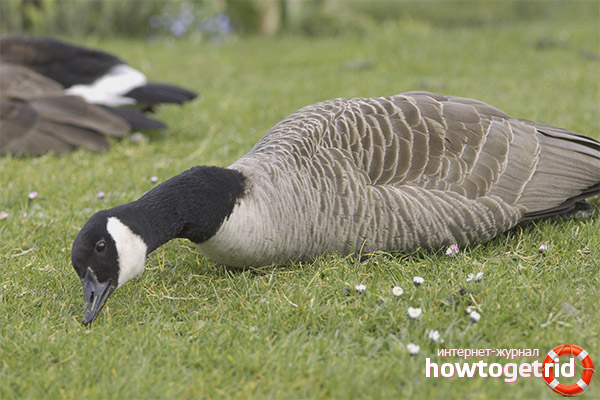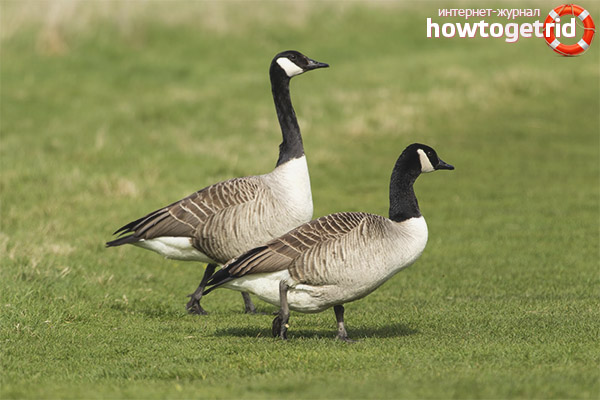The content of the article
Canadian goose are valued for quality down, they are compared with the Canadian geese. It is on the basis of this fluff that the leading manufacturers of outerwear make down jackets. However, some are not interested in the quality of fluff, but in the description and other features of the birds represented. So, for example, where they live, what interesting facts exist, how this subspecies is protected. Let's not get ahead of ourselves, we will study all aspects in order of priority.
Features
- Presented birds are classified as waterfowl; today, about a dozen varieties of represented birds are distinguished. Specialists researching geese subdivide them into 2 varieties that have distinctive external data. It is a goose, according to ornithologists, is ranked among this ten. All birds are distinguished by their behavior and down. Judging by the official version, more than 12 species of geese found in the USA and Canada are distinguished.
- Usually these individuals are divided by the weight that is inherent in an adult. Geese are small and large. The species of large individuals is distinguished by its dense plumage, in appearance they are similar to ordinary domestic geese. Small geese, by their weight data, are partially similar to wild ducks or young from a flock of geese. Hunters, of course, appreciate more large individuals.
- Wild goose means a source of fluff and meat. Therefore, it is imperative that the individual in its natural habitat eats properly, does not get sick. Only under these conditions will fluff be suitable for further processing. To get a warm down jacket or park, you need to use fluff exclusively for adults from two years and older. Such models of outerwear turn out to be quite warm, they are easy to care for, the fluff does not knock out and does not roll up with tangles.
Description
- According to their overall characteristics, birds grow up to 70–80 cm. Moreover, their wingspan is 100–120 cm. As for the mass, it can reach 1-3 kg. According to external data, geese are similar to geese, so some called them mini-geese. It has long been believed that the represented family acts as a subspecies of their Canadian counterparts.
- If you look at the birds standing nearby, it is difficult to identify their differences. Unless you pay attention exclusively to the dimensions, in all other respects these pets are similar. They may even have the same body weight or it will seem so to you due to abundant plumage. The bottom line is that the represented families almost do not differ from each other.
- However, if you follow the reviews and other data received from scientists, then the Canadian geese can still grow up to 7 kg. When the goose is in flight, its neck is not as long as that of the comrade presented above. As for behavior, the geese are louder, they scream and with their whole appearance show superiority over others. Geese are quiet.
- Regarding external data, the body is covered with gray feathers, on which brownish blots are clearly visible. There is also a white strip at the bottom of the head, extending from one ear to the other. In the sacral region there is a transverse wide ribbon, the tail is black and contrasting. Paws are also black. The beak differs in a different form, in comparison with geese. He's short. In the neck area there is a so-called white collar that descends to the lower part.
Habitat
- The birds of the represented breed group live in completely different corners of the planet. When preparation for procreation begins.They prefer forest areas, tundra and other thickets where there is a water source nearby.
- At the same time, individuals can feel great on the lawns, in the reed, near berry bushes and fruit trees. Subsequently, what is nearby acts as food for adults.
- When migration begins in the winter, individuals prefer small water bodies, whether it be marshy terrain, lakes or rivers. Birds with pleasure will remain in the area which has flooded from the sea. They love silt sites, pastures, lagoons with salted water.
- These migratory birds leave for warm places for the winter. When they begin to fly, they take on the zigzag position that the flock made up. Typically, the movement occurs in the evening or early morning. They can soar in the clouds for a couple of hours or more without stopping.
- In the process of soaring, they adhere to a speed of 50 km / h. They do not rise to too great a height, the maximum rises above the ground by 1 km. Whole families and single individuals are taken to the flock for the flight.
Food
- The presented breed of birds in the warm season lives on the territory of the tundra. Often, individuals give preference to plant foods when eating. Brant goose feast on berries, reeds and grass. Each time before migration, birds begin a period of abundant feeding. Often they eat cane seeds.
- Such nutrition allows goose goose to gain a sufficient amount of fat. As a result, this becomes the main source of energy for birds during a long flight. Among other things, the presented individuals often extract food from the water. They dive a short distance. Individuals get the plants they need.
- In the winter season, birds mostly stop at farm fields. Individuals feast on barley and winter wheat. Also, in addition to the main diet of the bird, all kinds of insects are added. Geese are very fond of mollusks and crustaceans.
Breeding
- The considered individuals reach puberty at the age of 1.5 years. It is believed that such birds are monogamous. Therefore, when creating a couple, they live a joint life for a long time. However, it is worth noting that with the loss of a partner, the second individual will soon find a new mate.
- As for nesting, geese prefer to stay in one permanent place. Often, representatives of the weaker sex independently choose a place for nesting. It should be high. In this case, individuals will be able to well view the entire surrounding area. Nevertheless, nests are built near rivers and reservoirs.
- Often you can find nests that are located on small islets that are in the water. Often individuals equip the nest with sedge, moss, lichen and their own feathers. At one time, the female is able to lay up to 5 eggs. She continues to hatch them for about 2 weeks.
- The male, in turn, all this time is engaged in the protection of the female and future offspring. After birth, chicks can leave the nest after only 1 day. At this age, they swim, walk, eat and dive without any problems. After 7 weeks, the young growth completely becomes independent and leaves the nest irrevocably. However, chicks can stay with their parents during the first winter.
Interesting Facts
- The considered individuals, as well as the Canadian geese, are considered one of the most common representatives of a kind on the northern American continent. The problem is that the specialists faced serious difficulties. They simply cannot identify all the subspecies and understand which one is most exposed to threats.
- In addition, such geese are particularly sensitive to environmental pollution.Particularly birds react sharply to the combination of pesticides and lead. In addition, individuals often become victims of hunters.
- The problem of reducing the population of a species also depends on the fact that minerals are extracted in the tundra. Such processes destroy the familiar habitat of the represented individuals. Most subspecies are protected by law, but the threat of species extinction remains.
- To date, according to expert estimates, the number of individuals in the world is only 3 million. In addition, these subspecies include all subspecies that are subject to various dangers.
The goose in question were brought to Europe for a relatively long time. In cooler regions, individuals took root without any problems. These birds are unique in nature. In addition, they are very beautiful. The population of the main species is declining, despite the fact that it is under protection.
Video: Canada Goose (Branta canadensis)












Submit